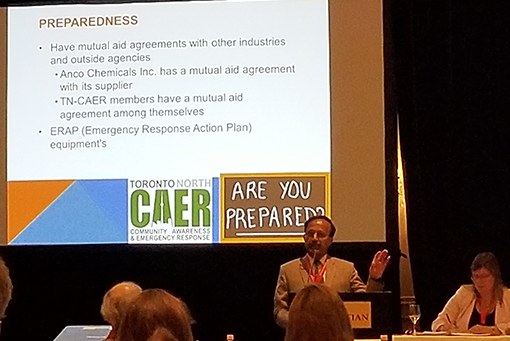Chris Wells of Transport Canada made a presentation called “TDG Regulations Update – Amendments in Progress”
Chris talked about upcoming changes to the TDG regulations. The training requirements in Part 6 are to be clarified to improve overall safety. Fees will be modernized. Progress has included the formation of a General Policy Advisory Council, webinar & consultation period (completed). Next steps include reviewing the proposal based on CGI comments, preparing digital consultations & developing guidance materials & awareness activities. The fees will only apply for initial and renewal applications. Cost payable every 5 years. On-line portal for submission and payment.
The International Harmonization Update of Part 12 for Air is proposed to modernize TDG domestic requirements by air to align with international codes. Consultations, support and consultation has already occurred. Next steps are reviewing proposal based on CGI comments and going in the Canada Gazette in early spring 2025.
Issues and gaps in Means of Containment in Part 5 are being internally consulted. Next steps include pre-consultation with industry in late spring 2024.
Consultations and amendments are found at https://tc.canada.ca/en/dangerous-goods/safety-awareness-materials-faq/recent-regulatory-consultations-upcoming-regulatory-amendments
Contacts:
- General TDG Information – TDG-TMD@tc.gc.ca
- Safety Awareness Team – TC.TDGSafetyAwareness-SensibiliisationalasecuritedduTMD.TC@tc.gc.ca
- Response Operations Team (ERAP Program) – TC.ChiefResponseOperations-ChefOperationsDeResponse.TC@tc.gc.ca
- Ontario TDG Regional Office – 1-216-973-1868 – TDG-TMDOntario@tc.gc.ca
Katy Joncas, Monica Blaney & Rakesh Virahsawmy of Transport Canada made a presentation called “TDG – On-Line Client Identification Database”
Katy talked about Part 17, Site Registration Requirements for the On-Line Client Identification Database. The progress to date is: legislative amendment was tabled in the fall of 2022; digital solution is close to completion; pilot testing continues; CGI in June 2022 followed by a 70-day consultation period; general support from stakeholders was received in fall of 2022; and regulatory package completed & approved. The next steps are finalizing awareness material for implementation; completing the digital platform; and CGII in fall of 2023.
The proposed changes are to repeal the extended information requirements. Modifications include: the reporting data based on previous fiscal year (rather than year); renewal date changed to within 30 days of anniversary date (previously anniversary date); update administrative information within 60 days of the change (previously 30 days); and 2 contacts per business (rather than per site). Modify Site definition and provide more guidance documents; and requires that all persons re registered prior to beginning the DG activities including a 12-month transition period.
For more information on the TDG Client Identification Database email TDGCID-BDICTMD@tc.gc.ca.
Monica introduced Rakesh Virahsawmy from TC who is working on CID implementation including a portal & support. The portal should be able to pull business info from the CRA. Monica added that this should mean less imputing data such as addresses & legal descriptions.



 Lisa Bolton of Sherrard Kuzz LLP made a presentation on COVID-19 Vaccination and the Workplace. The presentation was on screening customers/visitors for vaccinations; mandatory employee vaccinations; and compliance with current health & safety requirements to address COVID-19.
Lisa Bolton of Sherrard Kuzz LLP made a presentation on COVID-19 Vaccination and the Workplace. The presentation was on screening customers/visitors for vaccinations; mandatory employee vaccinations; and compliance with current health & safety requirements to address COVID-19.








 Poonam Chodha of Amazon toured the CAER group around the Amazon Fulfillment Centre in Brampton. The Brampton Fulfillment Center is an 80,000 sq. ft. facility on 4 floors which services the Canadian market from Brampton. The operations are made up of inbound and outbound departments. Inbound receives products from hundreds of vendors. Once received, these products become available on the Amazon website to order. Outbound operations, fulfills customer orders by picking, packing and shipping customer orders within specific and tight deadlines. The group toured the facility seeing robots, belt conveyors, packing stations and the shipping of the outgoing goods.
Poonam Chodha of Amazon toured the CAER group around the Amazon Fulfillment Centre in Brampton. The Brampton Fulfillment Center is an 80,000 sq. ft. facility on 4 floors which services the Canadian market from Brampton. The operations are made up of inbound and outbound departments. Inbound receives products from hundreds of vendors. Once received, these products become available on the Amazon website to order. Outbound operations, fulfills customer orders by picking, packing and shipping customer orders within specific and tight deadlines. The group toured the facility seeing robots, belt conveyors, packing stations and the shipping of the outgoing goods.

 Sharon Walker of Vaughan Emergency Planning made a presentation at the CANECT conference on Planning E2 Exercises. The first step is to contact municipality for assistance and participation in exercise. Business must decide when to hold an exercise, weather considerations, time of day and implications to neighbouring industries/businesses. They must choose the types of exercise (notification, case study, table top, simulation cell and field exercise). When planning the exercise you do need to: know your goals and objectives; what you plan to achieve; what are you exercising (part of the plan or the whole plan); and is the training and practice for staff or the evaluation of relevance and effectiveness of the plan. She suggested to create a 5 year schedule to work up to the field exercise. The Exercise Planning Objectives should be simple, measurable, achievable, realistic and time specific. To develop your exercise: create a scenario, determine the scale or size of the incident, the internal and external participants and establish a planning team.
Sharon Walker of Vaughan Emergency Planning made a presentation at the CANECT conference on Planning E2 Exercises. The first step is to contact municipality for assistance and participation in exercise. Business must decide when to hold an exercise, weather considerations, time of day and implications to neighbouring industries/businesses. They must choose the types of exercise (notification, case study, table top, simulation cell and field exercise). When planning the exercise you do need to: know your goals and objectives; what you plan to achieve; what are you exercising (part of the plan or the whole plan); and is the training and practice for staff or the evaluation of relevance and effectiveness of the plan. She suggested to create a 5 year schedule to work up to the field exercise. The Exercise Planning Objectives should be simple, measurable, achievable, realistic and time specific. To develop your exercise: create a scenario, determine the scale or size of the incident, the internal and external participants and establish a planning team.





